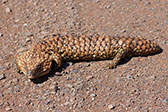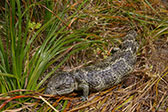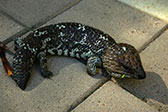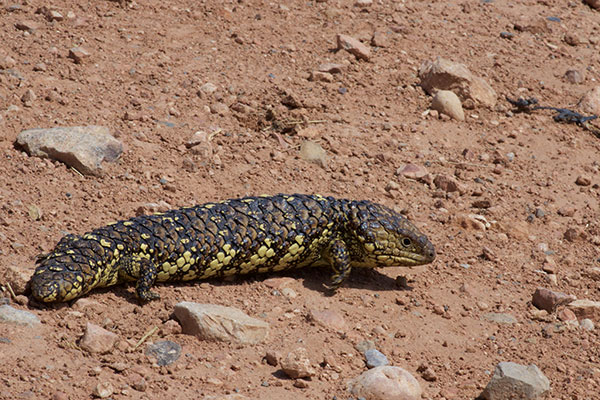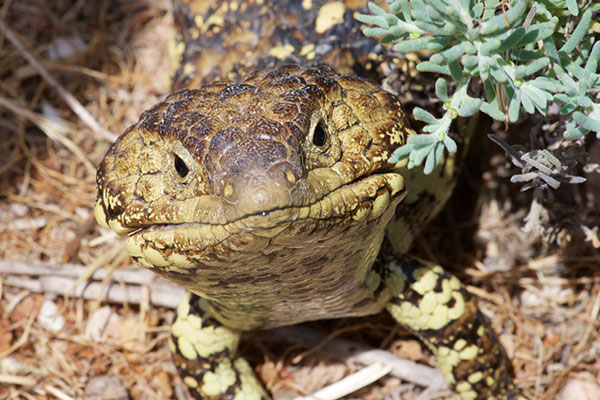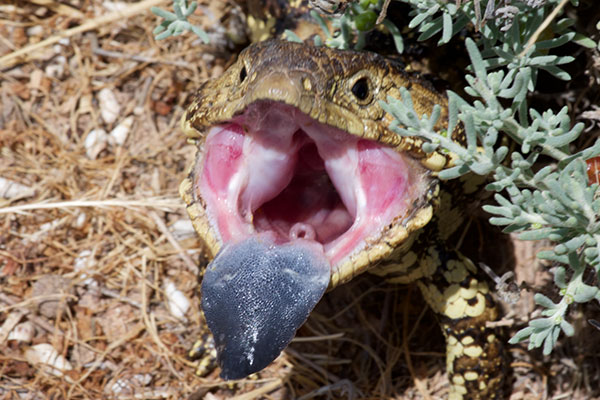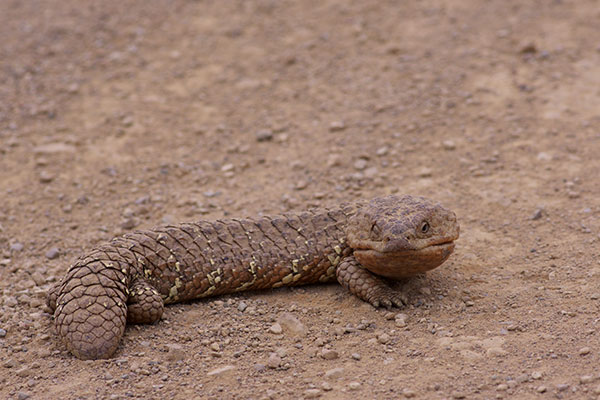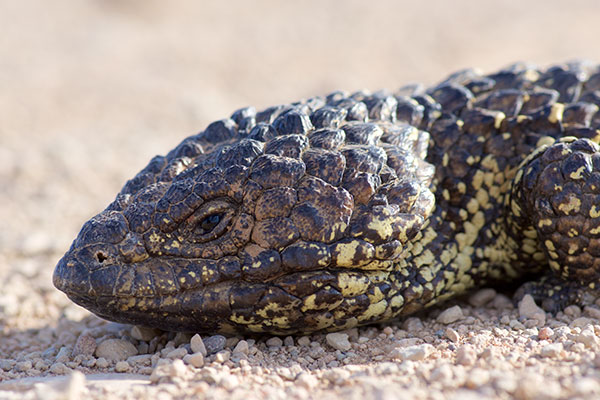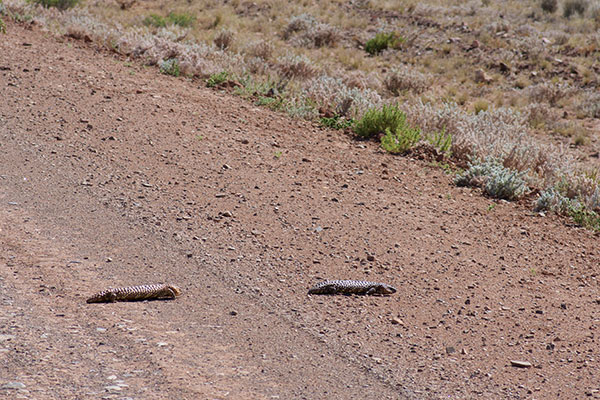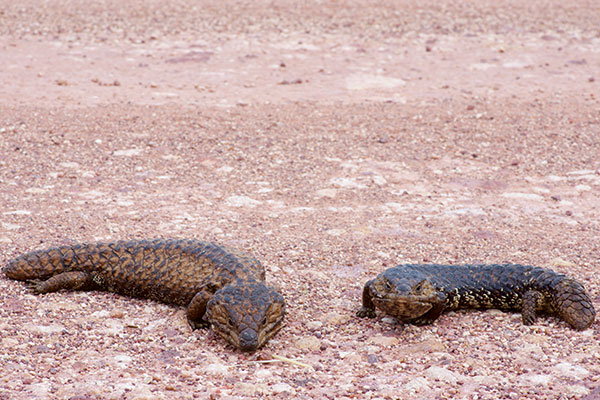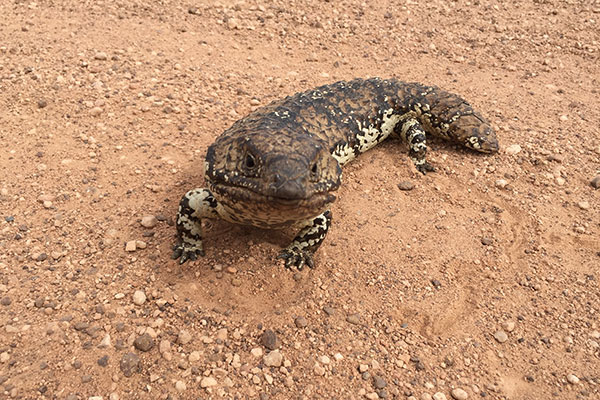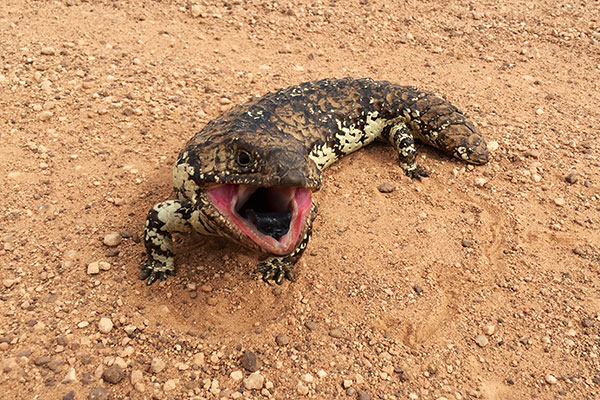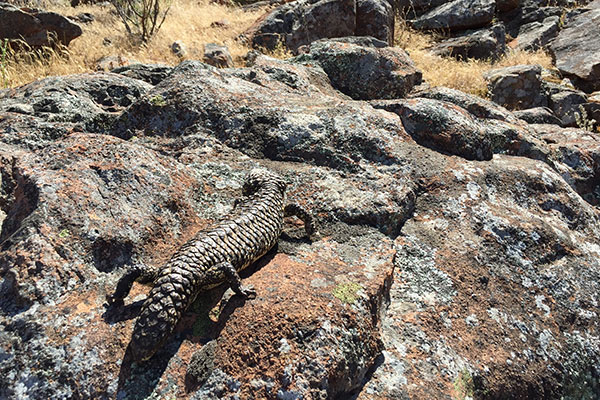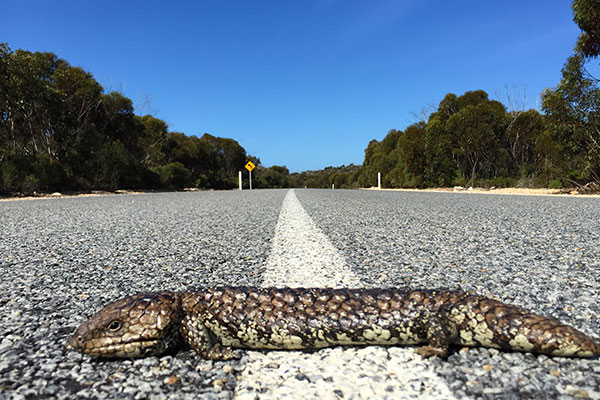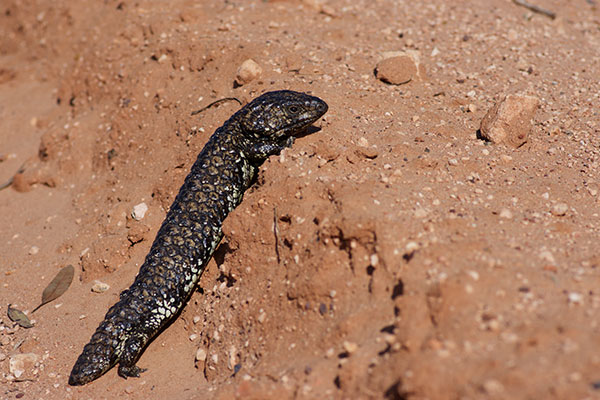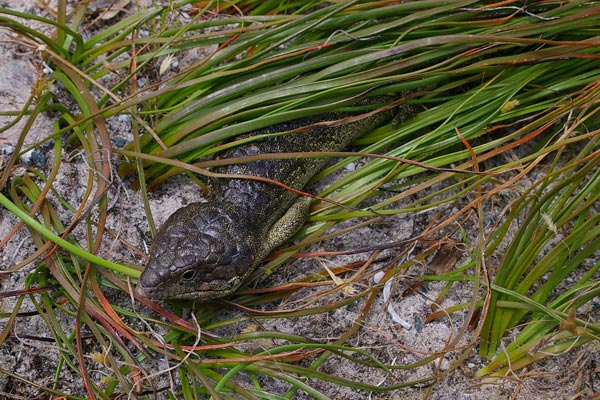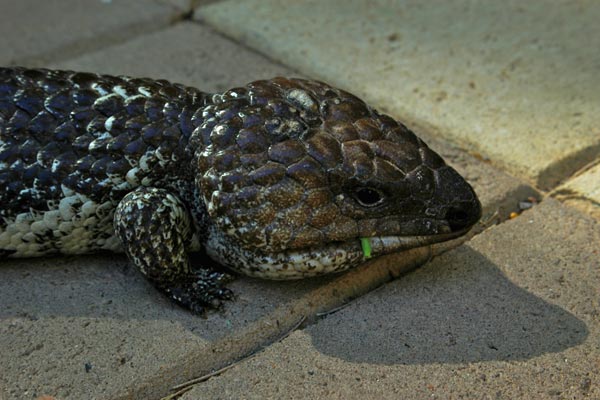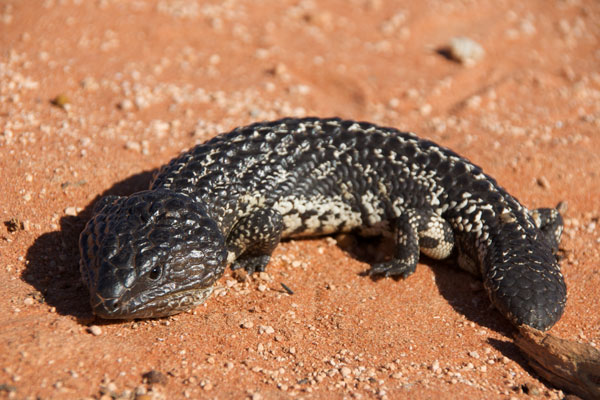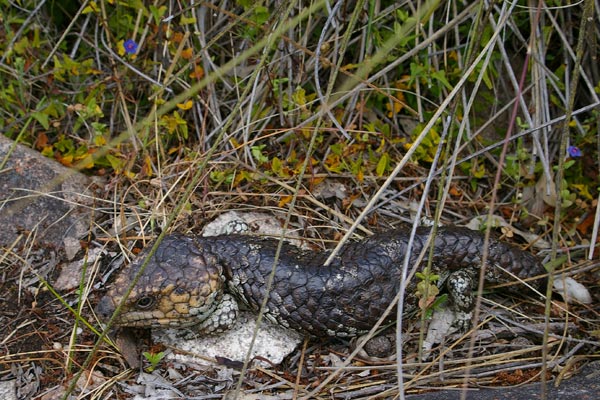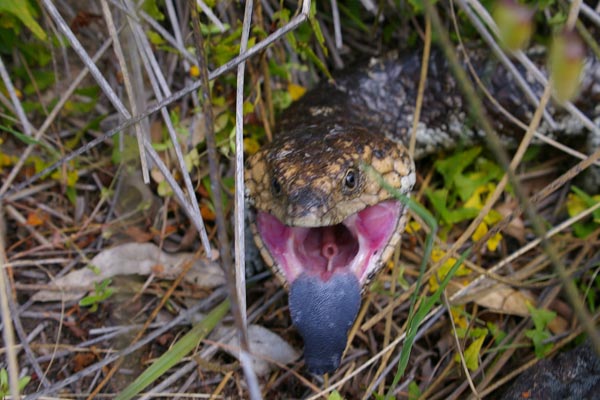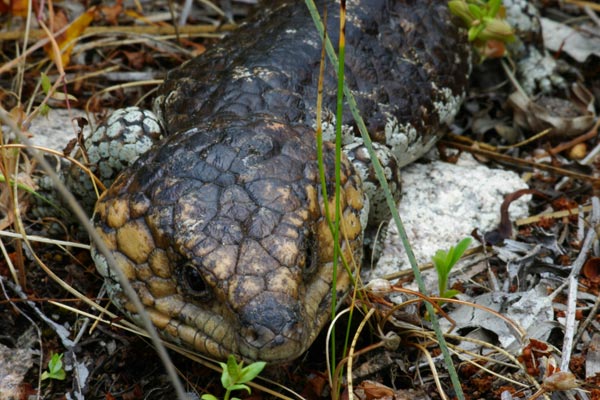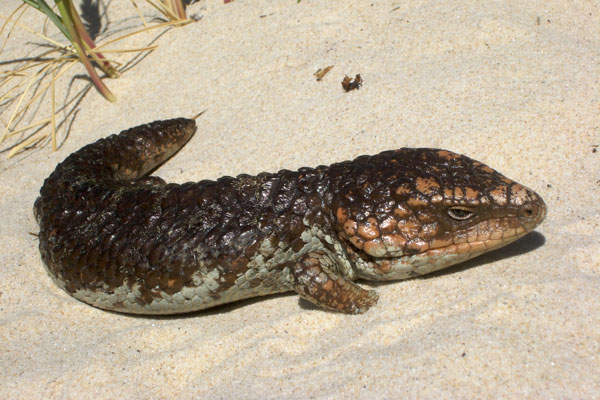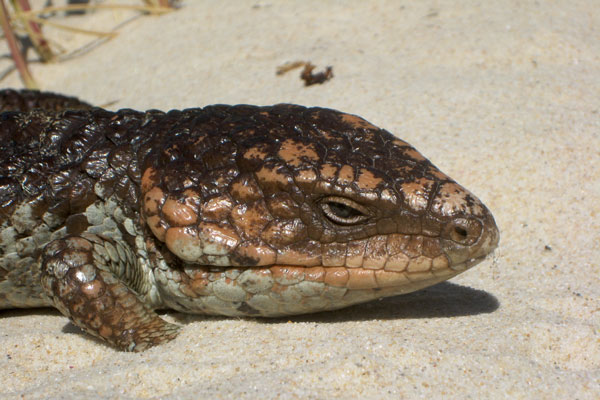Tiliqua rugosa
—
Shingleback
Also known as:
Bobtail, Stump-tailed Skink, Stumpy-tail, Sleepy Lizard, Pinecone Lizard, Boggi
Subspecies I've seen:
Tiliqua rugosa aspera
—
Eastern Shingleback
Nelshaby, South Australia, Australia—October 17, 2015
This fine specimen of grumpy and charming lizard was my first Eastern Shingleback. Many more were to follow. An overview of the complete set from this particular trip to Australia can be found
elsewhere on this website.
Bunyeroo Road, Flinders Ranges National Park, South Australia, Australia—October 19, 2015
This poor old guy had a damaged (maybe missing?) right eye, but otherwise seemed to be doing just fine. I take back the "poor old" part.
Wilmington Road, near Hammond, South Australia, Australia—October 19, 2015
When they are worried about your approach, a Shingleback will deploy one of its three defenses. It might try to clamber away. It might open its big mouth and show off its big blue tongue in a ridiculous attempt to scare you. Or it might just hunker down and take a nap, hoping that you didn't notice it. This one chose the latter reaction.
Copley Road, near Balcoona, South Australia, Australia—October 22, 2015
Eastern Shinglebacks have bigger, more shingle-like scales than the other Shingleback subspecies. This one is a particularly good example of why some locals call them "Pine Cone Lizards".
Wirrealpa Road, South Australia, Australia—October 22, 2015
Unlike the vast majority of lizards, Shinglebacks tend to be monogamous. In fact, if you Google "monogamous lizard", you will be hard-pressed to find any other examples. During the breeding season, couples are often within a foot or two of each other for weeks or even months at a time.
Pinkawillinie Conservation Park, South Australia, Australia—October 25, 2015
Another happy couple. Don't they look happy?
Pinkawillinie, South Australia, Australia—October 25, 2015
Dang, a Shingleback pretending to be fierce is just too cute.
Policeman's Point, Gawler Ranges National Park, South Australia, Australia—October 26, 2015
When they are found in their native habitat rather than crossing roads, they blend in with their surroundings a lot better.
Lincoln National Park, South Australia, Australia—October 28, 2015
I saw this one from a distance as it was just beginning to cross the road. I was intending to get photos right away, but I then noticed an excellent
monitor lizard motionless in the road a few feet away. Monitor lizards are both much rarer and much faster than Shinglebacks, so I spent some time carefully trying to photograph the monitor without scaring it away, and the Shingleback slipped my mind. When I eventually finished with the monitor, I remembered the Shingleback, and assumed that it had finished crossing the road and vanished into the bush. But I should not have underestimated the legendary laziness of the Sleepy Lizard.
Middleback Road, near Nilginee, South Australia, Australia—October 29, 2015
My final Shingleback of the trip, making a mad dash for freedom. Most lizards would not be slowed much by a hard-packed six-inch berm at the side of a dirt road, but then Shinglebacks are not most lizards.
Tiliqua rugosa konowi
—
Rottnest Island Shingleback
Rottnest Island, Western Australia, Australia—November 7, 2005
I saw my first wild Shingleback on Rottnest Island on a cool, sometimes rainy day. Then I saw my second, third, and fourth as well. I quickly learned that it's not very hard to find Shinglebacks in this part of Australia.
These are absolutely huge skinks by any American measure, but compared to the other Shingleback subspecies, the ones on Rottnest Island are actually quite small.
Here is a complete list of the reptiles and frogs I saw on this trip to Western Australia.
Tiliqua rugosa palarra
—
Shark Bay Shingleback
Denham, Western Australia, Australia—November 12, 2005
Shinglebacks are familiar backyard friends to many Australians. They get along well in household gardens, helping themselves to the snails that infest such gardens, and perhaps to some nice produce here and there as well. This one was meandering across the patio of the villas in Denham that we had planned to occupy. (We ended up abandoning them and staying in Monkey Mia instead.) It looks like a wee bit of garden is sticking out of this skink's mouth.
The Shinglebacks in the Shark Bay area have somewhat less blunt ends than the other subspecies. You can see that this one's snout and especially tail are considerably pointier than the other subspecies I photographed.
Here is a complete list of the reptiles and frogs I saw on this trip to Western Australia.
Peron Peninsula, Shark Bay World Heritage Area, Western Australia, Australia—November 25, 2009
We drove back and forth across the Denham - Monkey Mia road numerous times unsuccessfully searching for thorny devils. This goofy lizard was a worthwhile consolation prize though.
I’ve written up an account of this three-week trip to Australia here.
Tiliqua rugosa rugosa
—
Common Shingleback
Walyunga National Park, Western Australia, Australia—November 8, 2005
The day after I saw my first wild Shinglebacks on Rottnest Island, I saw a couple more at Walyunga National Park near Perth. These were the larger
T. r. rugosa subspecies. Shinglebacks are quite slow-moving and charming creatures, but when one feels cornered it will gape wide and flash its blue tongue in an attempt to appear frightening. I'm not really sure whether the wide gape and big head means that they bite hard; I didn't perform that particular experiment. (Ten years later, when I saw many Eastern Shinglebacks, I did perform that experiment many times. None of them actually attempted to bite; apparently the display is all bluff.)
Here is a complete list of the reptiles and frogs I saw on this trip to Western Australia.
Perth, Western Australia, Australia—November 21, 2009
This fine fellow, the first Shingleback that my sister Mary had seen, was really living up to the name “Sleepy Lizard”. Mary pointed out that it was more like a toy-store rubber lizard than an actual lizard in appearance, texture, and disposition.
I’ve written up an account of this three-week trip to Australia here.
Printed references:
- Bush, B., Maryan, B., Browne-Cooper, R., Robinson, D. 1995. A Guide to the Reptiles and Frogs of the Perth Region
- Cogger, H. G. 2014. Reptiles & Amphibians of Australia, Seventh Edition
- Cohen, M., et al 2000. Watching Wildlife: Australia
- Hoser, R. T. 1989. Australian Reptiles & Frogs
- Swan, G. 1995. A Photographic Guide to Snakes & Other Reptiles of Australia
- Wilson, S. K., Knowles, D. 1988. Australia's Reptiles: A Photographic Reference to the Terrestrial Reptiles of Australia
- Wilson, S. and Swan, G. 2003. Reptiles of Australia
